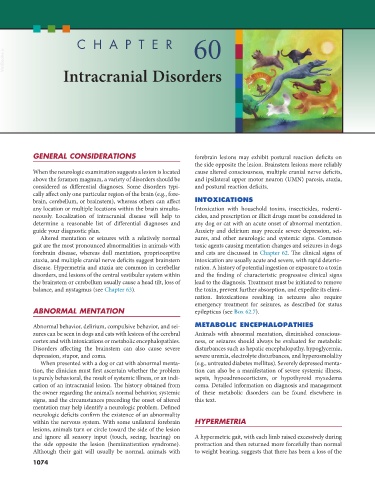Page 1102 - Small Animal Internal Medicine, 6th Edition
P. 1102
1074 PART IX Nervous System and Neuromuscular Disorders
CHAPTER 60
VetBooks.ir
Intracranial Disorders
GENERAL CONSIDERATIONS forebrain lesions may exhibit postural reaction deficits on
the side opposite the lesion. Brainstem lesions more reliably
When the neurologic examination suggests a lesion is located cause altered consciousness, multiple cranial nerve deficits,
above the foramen magnum, a variety of disorders should be and ipsilateral upper motor neuron (UMN) paresis, ataxia,
considered as differential diagnoses. Some disorders typi- and postural reaction deficits.
cally affect only one particular region of the brain (e.g., fore-
brain, cerebellum, or brainstem), whereas others can affect INTOXICATIONS
any location or multiple locations within the brain simulta- Intoxication with household toxins, insecticides, rodenti-
neously. Localization of intracranial disease will help to cides, and prescription or illicit drugs must be considered in
determine a reasonable list of differential diagnoses and any dog or cat with an acute onset of abnormal mentation.
guide your diagnostic plan. Anxiety and delirium may precede severe depression, sei-
Altered mentation or seizures with a relatively normal zures, and other neurologic and systemic signs. Common
gait are the most pronounced abnormalities in animals with toxic agents causing mentation changes and seizures in dogs
forebrain disease, whereas dull mentation, proprioceptive and cats are discussed in Chapter 62. The clinical signs of
ataxia, and multiple cranial nerve deficits suggest brainstem intoxication are usually acute and severe, with rapid deterio-
disease. Hypermetria and ataxia are common in cerebellar ration. A history of potential ingestion or exposure to a toxin
disorders, and lesions of the central vestibular system within and the finding of characteristic progressive clinical signs
the brainstem or cerebellum usually cause a head tilt, loss of lead to the diagnosis. Treatment must be initiated to remove
balance, and nystagmus (see Chapter 63). the toxin, prevent further absorption, and expedite its elimi-
nation. Intoxications resulting in seizures also require
emergency treatment for seizures, as described for status
ABNORMAL MENTATION epilepticus (see Box 62.7).
Abnormal behavior, delirium, compulsive behavior, and sei- METABOLIC ENCEPHALOPATHIES
zures can be seen in dogs and cats with lesions of the cerebral Animals with abnormal mentation, diminished conscious-
cortex and with intoxications or metabolic encephalopathies. ness, or seizures should always be evaluated for metabolic
Disorders affecting the brainstem can also cause severe disturbances such as hepatic encephalopathy, hypoglycemia,
depression, stupor, and coma. severe uremia, electrolyte disturbances, and hyperosmolality
When presented with a dog or cat with abnormal menta- (e.g., untreated diabetes mellitus). Severely depressed menta-
tion, the clinician must first ascertain whether the problem tion can also be a manifestation of severe systemic illness,
is purely behavioral, the result of systemic illness, or an indi- sepsis, hypoadrenocorticism, or hypothyroid myxedema
cation of an intracranial lesion. The history obtained from coma. Detailed information on diagnosis and management
the owner regarding the animal’s normal behavior, systemic of these metabolic disorders can be found elsewhere in
signs, and the circumstances preceding the onset of altered this text.
mentation may help identify a neurologic problem. Defined
neurologic deficits confirm the existence of an abnormality
within the nervous system. With some unilateral forebrain HYPERMETRIA
lesions, animals turn or circle toward the side of the lesion
and ignore all sensory input (touch, seeing, hearing) on A hypermetric gait, with each limb raised excessively during
the side opposite the lesion (hemiinattention syndrome). protraction and then returned more forcefully than normal
Although their gait will usually be normal, animals with to weight bearing, suggests that there has been a loss of the
1074

